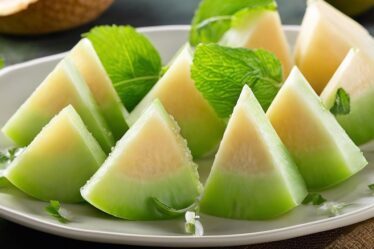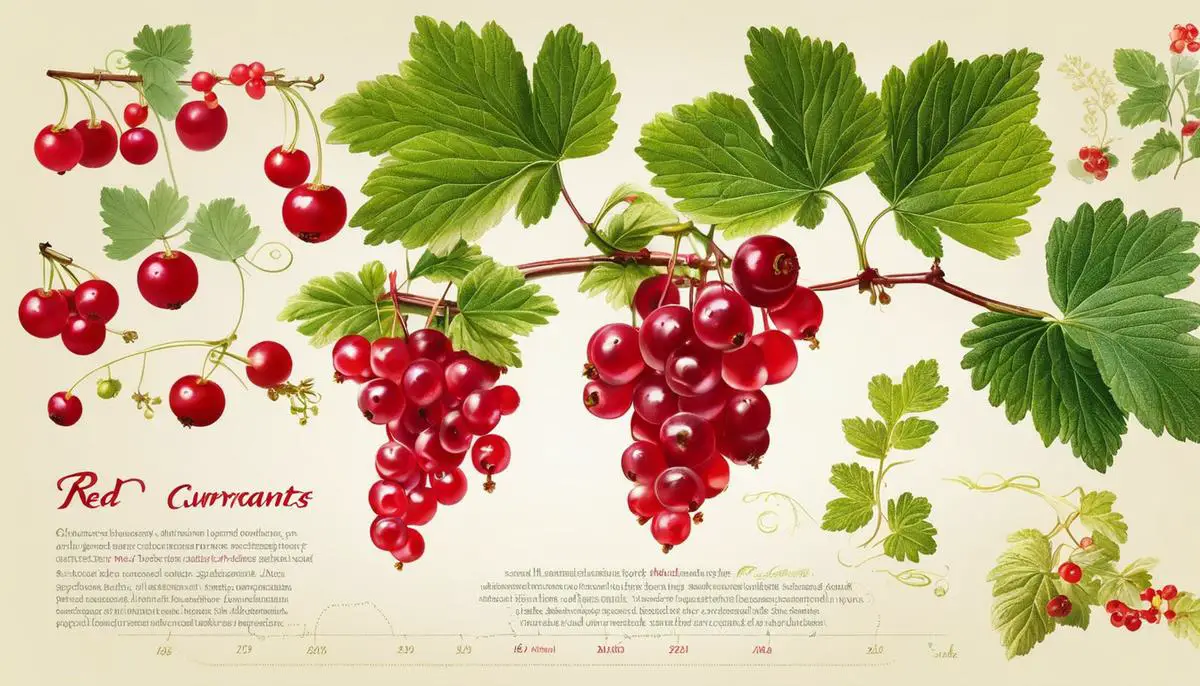
Tart Twist on Tradition: Elevate Your Meals with Red Currants
You may have glimpsed Red Currants nestled in the shelves of the produce aisle, scarlet orbs of tart delight, begging to be explored – yes, we speak of the oft-overlooked but highly nutritious Red Currants. Tracing these vibrant berries from their genesis to your grocery, the journey is rich with fascinating tales, nutritional gems, and delightful culinary adventures. But beyond their startling crimson allure, the story of red currants is intertwined with culture, cuisine, and a surprising wealth of health benefits. This exploration of red currants will take you on a journey, uncovering their historical roots, understanding their nutritional bounty, experimenting with their culinary potential, and last but not least, surprising you with compelling trivia.
History and Cultivation of Red Currants
A Crimson Journey: The Evolution of Red Currant Cultivation and Use
The allure of food draws much of its charm from its ability to reflect history, illustrate culture and bring people together. One such fascinating morsel that exemplifies this notion is the seemingly modest, but deeply illustrious and tantalisingly tart, red currant.
Hailing from the lands of Northern Europe, the red currant’s powerful history of cultivation began over 400 years ago. This shiny, ruby-hued fruit was not a desired delicacy at the outset. The wild Eurasian variety, known as “Ribes rubrum,” was viewed more as an annoying underbrush than a potential source of food. However, the appearance of red currants on the culinary scene marked the debut of an unsung hero that would eventually stir the fascination of gastronomers.
In the beginning, these berry bushes were harvested from their wild habitats, primarily for their leaves and fruits, which were found in a smorgasbord of savory and sweet dishes. Furthermore, the berries were an excellent source of Vitamin C, which helped soldiers and those affected by scurvy during the Great Age of Sail.
As our palates evolved, so did the cultivation and use of red currants. Intense farming practices commenced during the 19th century across Europe, mainly in the United Kingdom and France. This unassuming fruit soon found its place nestled alongside heavy meats, glazing roasts with a tangy-sweet profile that dance on the tongue, invoking a symphony of flavors that elevates each bite.
The red currant’s road to prominence was not without obstacles. In the United States, the cultivation of these little red gems was dictated by the White Pine Blister Rust epidemic during the 20th century. To prevent the spread of this harmful pathogen that threatened the timber industry, the cultivation of red currants was banned. It was only in the 1960s, after thorough scientific research and better disease management, that these prohibitions began to relax, breathing life once again into this beautiful fruit’s future.
Fast forward to the present day, and these ruby jewels are celebrated in some of the most refined kitchens globally. Red currants have become a sensation, partnering with savory meats, adorning decadent pastries, and contributing their robust flavor to sauces, jellies, and wines. Chefs passionately experiment with transforming this humble berry into gastronomic expressions of delight that strike a balance between nostalgia and innovation.
Farm-to-table restaurants are reviving the charm of red currants, honoring their rich history and sustainable cultivation practices. Small growers and organic farms are once again thriving, ensuring that these scarlet berries continue to charm our palates for generations to come.
And so, the red currant remains, deep-rooted in our lives, a silent witness to years of gastronomic evolution, inherent in a multitude of cultures and cuisines, forging connections and conversations over shared plates. A fruit, though small in size, grand in its offering, continues to leave an indelible mark on the world of gastronomy, uniting us with its history, versatility, and the sheer joy of eating.
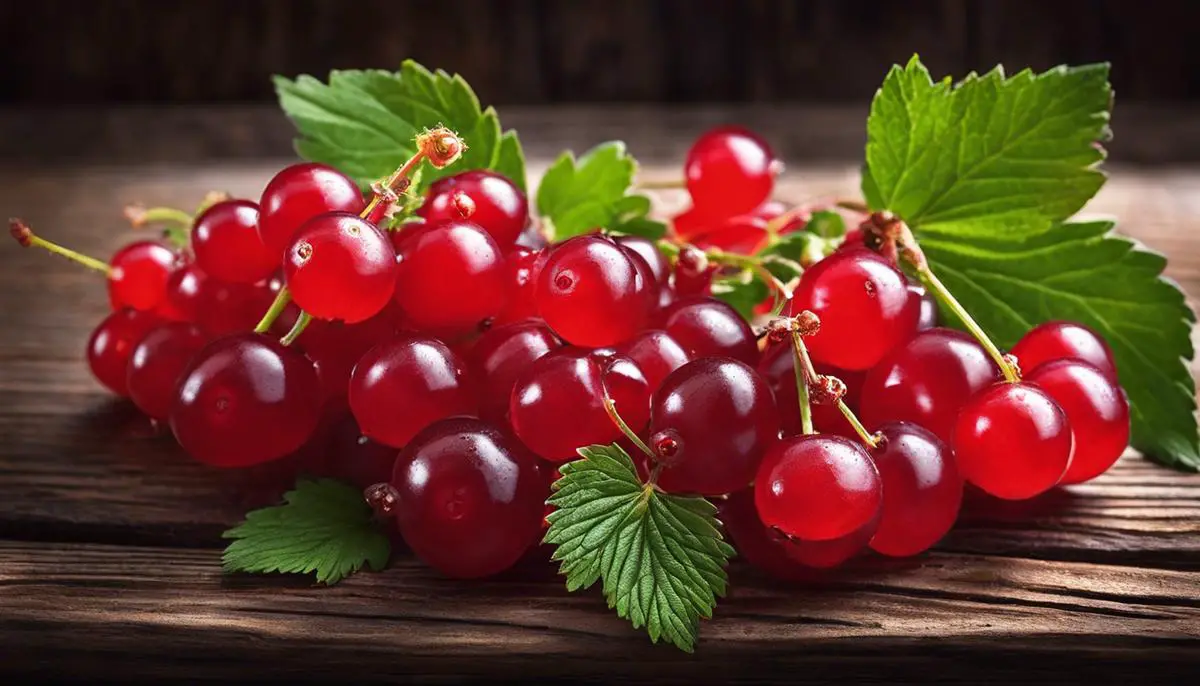
Nutritional Profile and Health Benefits of Red Currants
Continuing with the culinary journey of red currants, this tiny yet potent fruit proves it’s much more than just a fancy fixture in high-end cuisines and a gastronomic connector across cultures. It harbors a myriad of nutritional benefits that enhance health in more ways than one might perceive on initial encounter. Delving deeper, let’s decode the nutritional worth this ruby-red gem carries within its small chassis.
First, let’s begin with the facts: red currants are packed with dietary fiber, which fuels the body and keeps hunger at bay. A single serving of red currants provides about 15% of the recommended daily value of dietary fiber. Eating fiber-rich foods like red currants helps maintain a healthy digestive system, aids with weight management, and potentially lowers the risk of developing chronic conditions such as heart disease, diabetes, and certain types of cancer.
In addition to this, red currants are an excellent source of manganese, a key trace mineral. Manganese serves multiple functions to keep the body running smoothly – it aids in the formation of connective tissue, bones, and blood clotting factors, and plays a vital role in fat and carbohydrate metabolism, calcium absorption, and blood sugar regulation.
As if these facts were not impressive enough, red currants also prove to be a worthwhile source of antioxidants, specifically polyphenols. These compounds combat oxidative stress, reducing the risk of chronic diseases while contributing to the overall wellness and longevity of individuals. Incorporating red currants into the diet contributes to a powerful antioxidant defense against harmful free radicals, and promotes healthier, glowing skin.
A fun fact for the food aficionados out there – red currants can play a pivotal role in rejuvenating the iron stores in the body. The high content of Vitamin C present in red currants facilitates the absorption of iron, thus helping to alleviate conditions like anemia.
Furthermore, these little red jewels contain a decent amount of potassium, an essential mineral for maintaining a healthy heart and blood pressure levels. Regular consumption of potassium-rich foods like red currants can reduce the risk of strokes and heart disease.
With such a powerful punch of nutrients, it’s no wonder that this versatile fruit is making its way into recipes far beyond roasts, sauces, and pastries. From shaking up smoothies to enhancing salads, red currants are proving to be not just a culinary delight but a superfood, advancing health with every delicious nibble.
So whether you’re a seasoned chef, an experimental foodie, or someone just paving your path through the gastronomic world, incorporating red currants into the diet might be a move worth considering – not only for their tantalizing tartness but also for the myriad of nutritional benefits they offer. With red currants, you’re investing in health, flavor, and that quintessential gourmet edge. So go ahead, let’s celebrate this culinary hero and its contributions to a healthier, more flavorful world.
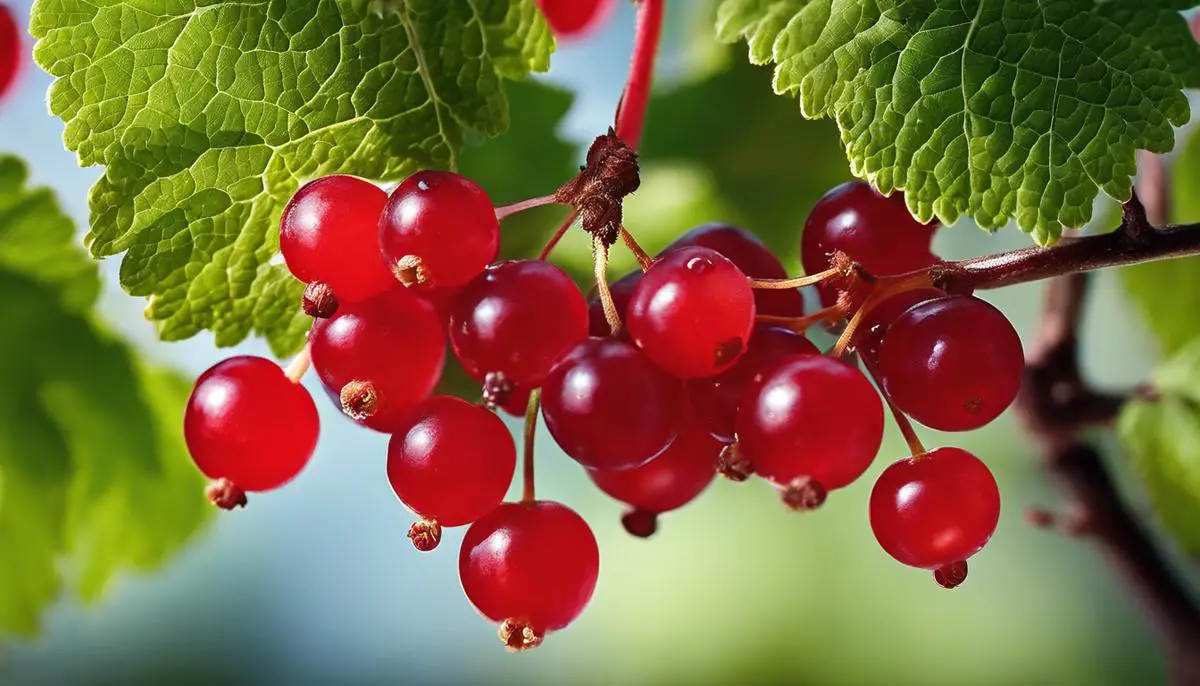
Innovative Recipes Incorporating Red Currants
There is a sense of exhilaration that takes over when we weave together taste sensations we wouldn’t usually consider. This sensation, this joy of discovery is what red currants bring to our culinary explorations. Its tangy flavor and ruby-like vibrancy ignite creativity and take the usual to a new plateau of the exciting. Nothing embodies this more than discovering the versatility of red currants in day-to-day meals.
A hero of the breakfast table, red currants can be stirred into granola or sprinkled over creamy Greek yogurt. They impart a delightful tartness while waking up the senses with their enticing color. Take oatmeal from mundane to tantalizing, simply by adding a handful of fresh red currants. It creates an irresistible blend of sweet, savory, sour, and crunchy – a delightful ballet of flavors to kick-start the day.
Take a simple grilled cheese sandwich and turn it into an adventurous lunchtime delight by adding a layer of sweet-spicy red currant jam. Sharp cheddar stands up excellently to the sweet-tart preserves, creating an launching of flavors guaranteed to tickle the taste buds. And, salads are never the same old when you consider red currants’ ability to transform them into vibrant, flavor-packed meals. A smattering of red currants over crunchy greens, like arugula or spinach, with a drizzle of their tart and tangy vinaigrette, creates a refreshing culinary experience.
And dinner? Oh, picture this: baked salmon with a zingy red currant glaze. The tartness beautifully balances the fish’s natural fatty richness, taking it from a simple dinner to a gourmet experience. Not to mention their fresh inclusion in a midsummer salsa of diced mango and jalapeno, spooned over pan-seared chicken breasts. The resulting flavor combinations are not just exotic, they’re positively celestial!
Let’s not forget drinks and desserts. Consider making your own red currant spritzer – an invigorating blend of crushed red currants, lemon juice, and sparkling water. Serve it at your next cookout and watch your guests rave about your novel drink! Or what about transforming your fruit salad? Drizzle on a little red currant syrup for an intriguing twist. Light, zingy and exotically exciting, it’s the perfect conclusion to a meal on a hot summer evening.
The world of red currents is vast and richly versatile, urging you to curate new experiences and sensations with every dish. So, challenge yourself to introduce these little red gems into your next meal. The list of possibilities is only limited by the imagination – and that’s the thrilling part of culinary experimentation!
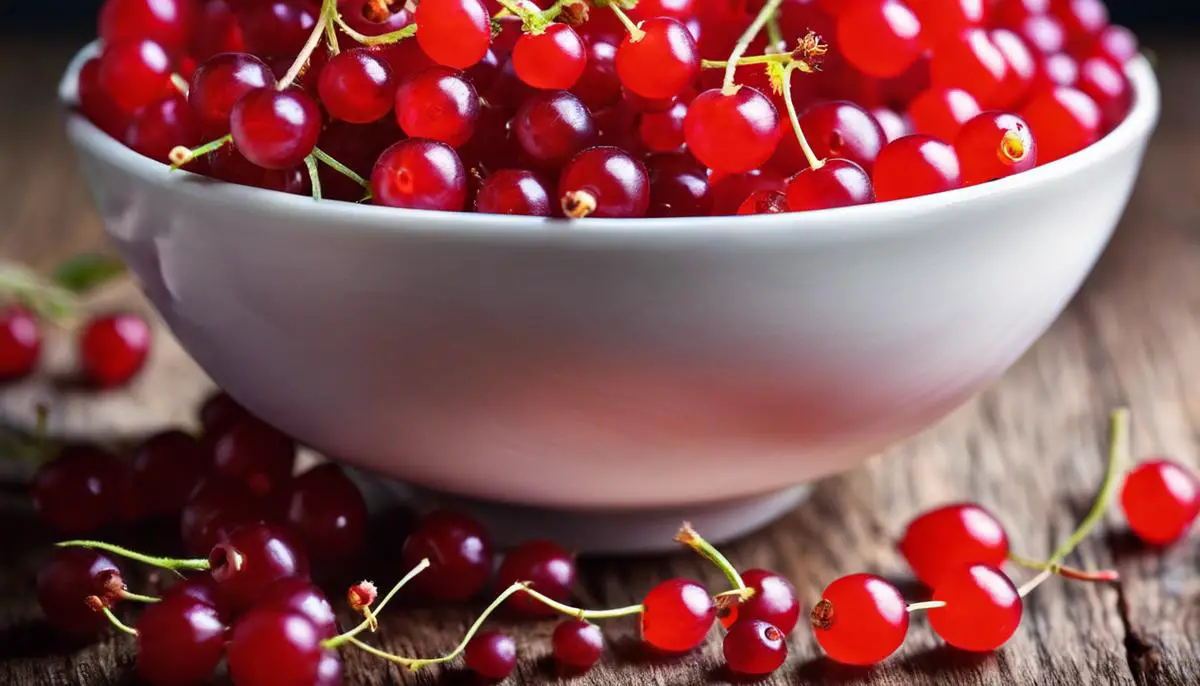
Facts and Fun Trivia about Red Currants
Let’s continue our culinary journey by delving into the lesser-known facts about red currants. Did you know that these ruby gems are known to proliferate quite rapidly? That’s right, these plants are peppy spreaders. Not only do they vow to fruit heavily even in partial shade, but their vigorous growth habit also allows for easy propagation. For cultivators and home garden enthusiasts, this results in a bounty of harvest in no time.
Another compelling quality lies in their hardiness. Red currants are impressively resistant to frost, allowing them to thrive in cold and temperate climates. It’s not a mere coincidence that they’re often found in the chilly regions of Northern Europe; these little berries are suited to take on the elements.
Continuing with the frost theme, let’s bring something frosty to the table. Have you ever tried your hand at making red currant ice cream? With their uniquely tart flavor profile, they create a refreshing contrast when combined with the rich creaminess of ice cream. Say hello to your new summer dessert staple!
Speaking of desserts, ever noticed how red currants often grace the tops of delicious pastries, cakes and tarts? Apart from the obvious burst of flavor they add, their brilliant red color is used to provide a striking visual contrast. They’re not just there for their fantastic taste; they’re there to make our food look irresistible too!
Moving on, let’s talk about red currant wine. This intense, burgundy-colored beverage is nothing short of a flavor launching. It’s a smooth, sweet, and sophisticated nectar that pairs excellently with a plate of mature cheeses, enhancing the overall dining experience.
On a bit of an unusual note, did you know that red currants were used as a remedy in traditional medicine? Its leaves were used to brew a type of tea, believed to soothe digestive problems while the berries were used for a multitude of ailments, including fever and gout.
To wrap up, let’s remind ourselves of the cosmopolitan versatility of red currants. Whether you’re upping the ante on your favorite sauce, brewing morning jam, enhancing a chocolate gateau, or simply enjoying them raw, these tiny berries prove the adage right – good things do come in small packages!
Embrace the culinary genius that resides within you, let your taste buds run wild and don’t be afraid to experiment with the amazing and versatile fruit that is the red currant. It’s a world full of delicious, enriching, and health-boosting possibilities, just waiting to be discovered!
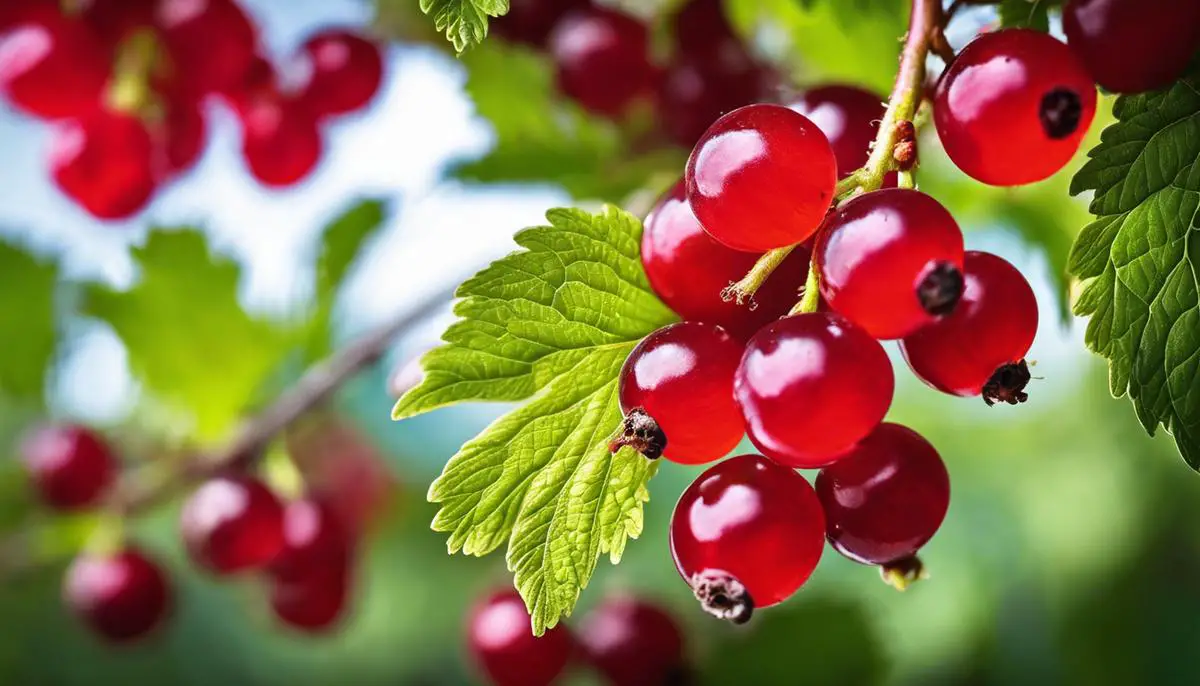
In the journey from farm to table, red currants have painted our lives red not just with their vibrant hue but also with the myriad health benefits they carry within their petite frames. These berries, once a staple of our ancestors’ diets, hold a promise for a future of flavorful, healthy eating. Whether you try your hand at innovative recipes featuring these punchy berries, delve deep into their abundant nutritional profile, or indulge in the intriguing trivia, red currants will continue to bring that welcome touch of tartness and health to global plates for many years to come. So, let the vibrant red of these remarkable berries guide you in your quest for balanced wellness and satisfying gastronomy.
.


